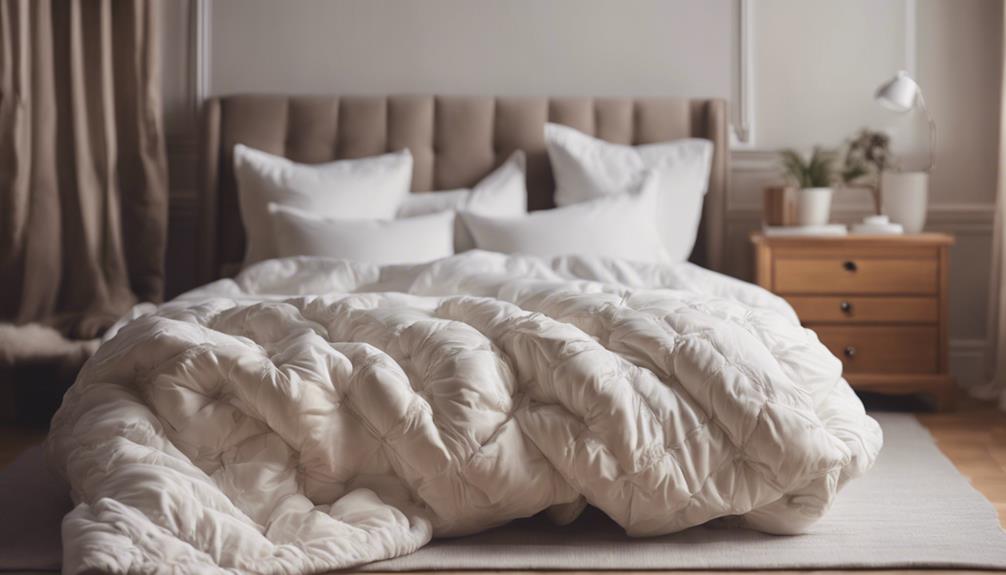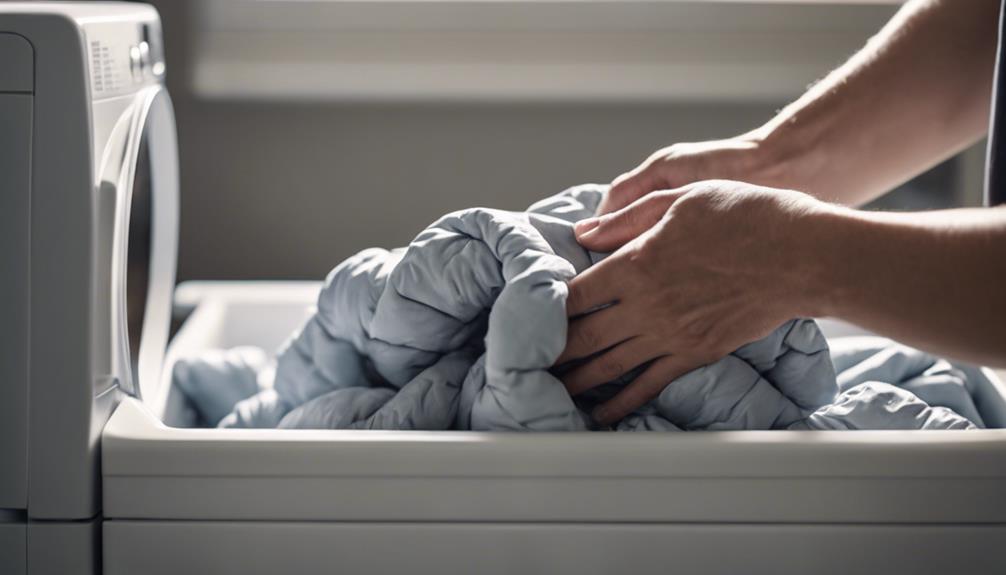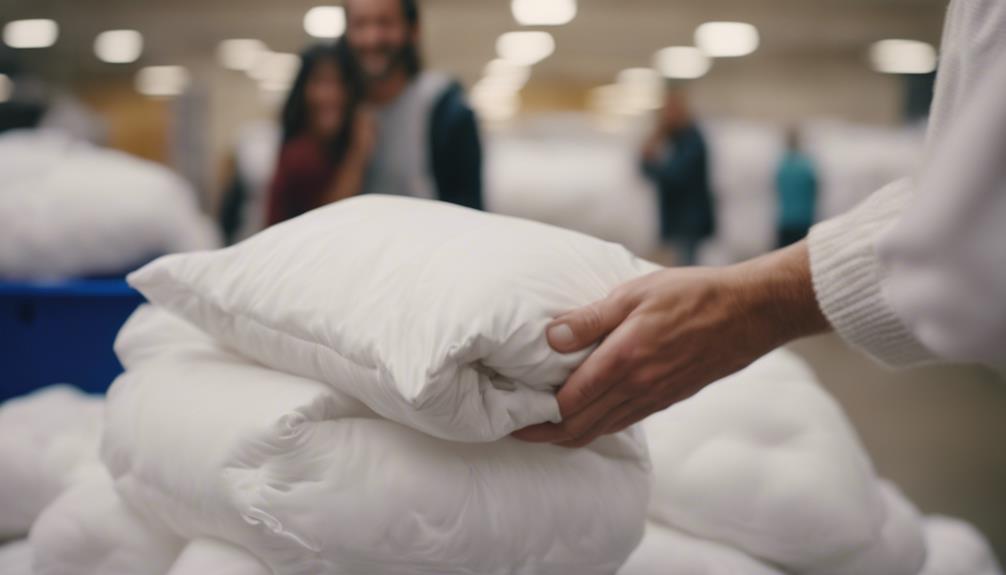When is the right time to give your baby a comforter? It’s recommended to introduce it around 7-9 months. At this age, babies begin seeking reassurance and comfort, which helps build positive sleep habits. It’s best to avoid introducing a comforter before 7 months due to safety concerns such as suffocation and choking risks. Benefits of introducing a comforter include providing warmth, security, and promoting better sleep quality. Select materials like cotton for breathability or silk for a more luxurious feel. Prioritize safety by choosing options that are free of choking hazards and always supervise your baby’s use of the comforter. When introducing the comforter, make it a regular, safe, and consistent part of your baby’s sleep routine. Comforters can help with self-soothing, support sleep training, and foster strong attachments. For safe and soothing sleep, choose a comforter wisely and start around 7 months – it’s crucial for your baby’s well-being.
Key Takeaways
- Introduce comforters around 7-9 months for security and positive sleep associations.
- Comforters offer warmth, comfort, and emotional soothing for babies.
- Establish stronger attachments with comforters at this age.
- Avoid risks by waiting until 7 months to introduce comforters.
- Use age-appropriate, safe, and breathable comforters for optimal sleep support.
Safe Age to Introduce Comforter

Around 7-9 months is considered the vital age to introduce a comforter to babies as they begin seeking reassurance and comfort during this developmental stage. Waiting until this age allows babies to establish a positive sleep association with the comforter. Babies are more likely to engage with and benefit from a comforter around this time.
Introducing a comforter too early may not be as effective in promoting self-soothing and security. It's essential to choose a safe and breathable comforter when introducing it to babies around 7 months. By waiting until this stage, parents can observe their baby's readiness for a comforter and make sure it becomes a helpful tool in promoting comfort and security during sleep.
This age range aligns with the developmental milestones where babies start forming stronger attachments to objects for comfort, making it an ideal time to introduce a comforter into their sleep routine.
Risks of Early Comforter Use

Using a comforter before the age of 7 months can pose serious risks to a baby's safety during sleep. Infants at this age lack the ability to move bedding away from their faces, increasing the potential for suffocation.
It's important to wait until after 7 months to introduce a comforter to reduce the risk of choking hazards and promote healthy self-soothing skills.
Potential Choking Hazard
Introducing a comforter to infants too early notably raises the risk of choking hazards due to their limited ability to remove objects from their mouths. Babies under 7 months are at a higher risk of choking on small comforter parts. To reduce the likelihood of choking incidents, safety guidelines recommend introducing comforters around 7-9 months when babies have developed better motor skills and coordination. Waiting until the baby is older can greatly decrease the chances of choking incidents related to comforter use. Below is a table illustrating the potential choking hazards associated with early comforter use:
| Age of Infant | Risk of Choking Hazard |
|---|---|
| Under 7 months | High |
| 7-9 months | Reduced |
| Over 9 months | Low |
Delayed Self-Soothing Skills
We must carefully consider the potential risks associated with introducing a comforter to babies too early, especially regarding the delay of their natural self-soothing skills. When babies rely heavily on a comforter for soothing, they may not learn essential self-soothing techniques.
Overuse of the comforter can hinder a baby's ability to calm themselves independently. This delay in self-soothing skills can lead to sleep disruptions when the comforter isn't available.
To promote healthy self-soothing development in babies, it's essential to strike a balance in comforter use. Encouraging babies to learn how to soothe themselves without external aids is beneficial for their overall well-being and independence.
Benefits of Comforter for Babies

Comforters offer babies warmth, security, and comfort as they navigate their sleep routines. These soft blankets can provide a soothing touch, helping infants feel safe and content during bedtime.
Additionally, comforters can act as a sleep aid, assisting babies in settling down and enjoying a restful night's sleep.
Warmth for Baby
Providing essential warmth and insulation, a comforter offers babies a cozy and regulated sleeping environment, guaranteeing ideal body temperature maintenance during rest. Babies benefit greatly from the added layer of warmth provided by a comforter, especially on colder nights or in rooms with drafts. This helps prevent overheating or chilling, creating a comfortable and snug sleeping space for your little one. By using a comforter, you are promoting a peaceful and restful sleep routine, supporting healthy sleep patterns and development. To make sure it's safe for babies, always choose a lightweight and breathable comforter suitable for their age. Below is a table summarizing key points about using a comforter for your baby:
| Benefits of a Comforter for Babies |
|---|
| Regulates body temperature |
| Prevents overheating or chilling |
| Enhances sleep quality |
Security and Comfort
Moving from ensuring warmth for your baby, let's now explore how comforters contribute to their sense of security and comfort. Comforters play an essential role in providing emotional soothing, security, and comfort to babies, helping them feel safe in new situations.
Contrary to what some may think, a baby's attachment to a comforter doesn't suggest insecurity; instead, it fosters emotional security through the love and predictability in parents' responses. By using comforters, babies learn to self-soothe, manage their emotions, and develop healthy attachments that aid in maneuvering changes smoothly.
Introducing comforters safely involves familiarizing babies with the item during playtime and bedtime routines, ensuring it's safe and washable, and allowing supervised use before 7-12 months to promote healthy sleep habits.
Sleep Aid for Infants
Embracing a sense of security and comfort, infants benefit greatly from the soothing presence of a familiar comfort item during sleep. Introducing a comforter when a baby starts to show signs of attachment, typically around 7-9 months, can assist in promoting self-soothing behaviors and a sense of safety.
Babies can form healthy attachments to their comforter, aiding in bedtime routines and changes. The comforter can also help manage emotions and provide comfort during episodes of separation anxiety. Using a safe and appropriate comfort item is essential to promote a sense of security and aid in soothing babies to sleep.
It's important to choose a comforter that's suitable for the baby's age and developmental stage, ensuring a safe and comforting sleep environment.
Comforter Vs. Blanket for Sleep

Comparing comforters to blankets for sleep reveals distinct benefits in promoting self-soothing and positive sleep associations for babies. When deciding between the two, here are some key points to take into account:
- Emotional Soothing: Comforters, unlike blankets, are specifically designed to provide emotional comfort and security during sleep.
- Bedtime Routine: Comforters can become part of a bedtime routine, helping babies associate them with sleep and relaxation.
- Safety: Comforters are safer alternatives to blankets in cribs, reducing the risk of suffocation or overheating.
- Self-Soothing: Introducing a comforter around 7 months can aid in adjustments and help babies learn to self-soothe during the night.
Choosing the Right Comforter Material

When selecting the right comforter material, it's important to explore different types of materials for comparison. Factors like warmth versus weight and allergy-friendly options play a significant role in determining the best comforter material for your needs.
Material Types Comparison
We often consider the material types when choosing the right comforter for our needs. Here are some comparisons to help you make an informed decision:
- Cotton: Breathable and easy to care for, ideal for those with allergies or sensitive skin.
- Wool: Excellent for temperature regulation, naturally moisture-wicking and insulating.
- Down: Lightweight yet provides excellent warmth, perfect for cold winter nights.
- Silk: Luxurious and hypoallergenic, offering a smooth and soft feel for a comfortable night's sleep.
Each material has its unique benefits, so consider your preferences and needs, whether it's for yourself, a baby to sleep safely, or for anyone seeking a good night's rest.
Warmth Vs. Weight
Finding the perfect balance between warmth and weight is essential when selecting the ideal comforter material for a comfortable night's sleep. To help you make an informed decision, we've prepared a comparison table below:
| Comforter Material | Warmth Level | Weight |
|---|---|---|
| Down Fill | High | Medium |
| Synthetic Fill | Moderate to High | Light |
| Cotton | Moderate | Light |
Considering the connection between sleep quality and comfort, it's vital to choose a comforter that provides adequate warmth without feeling too heavy. This balance is especially important for child health, as children's sleep can be influenced by the right bedding materials. By carefully evaluating warmth versus weight, you can ensure a restful night's sleep for yourself and your loved ones.
Allergy-Friendly Options
For individuals with allergies, selecting hypoallergenic materials such as cotton, bamboo, or silk is crucial when choosing an allergy-friendly comforter. When considering allergy-friendly options for your comforter, keep the following in mind:
- Avoid down-filled comforters: Down can trigger allergic reactions in some individuals.
- Look for certifications: Opt for comforters that are Oeko-Tex or GOTS certified to guarantee they're free from harmful chemicals.
- Regular washing: Wash your bedding, including the comforter, regularly in hot water to remove dust mites and allergens.
- Use a duvet cover: Choose a duvet cover that's easy to remove and wash frequently to maintain cleanliness and reduce allergens.
Comforter Safety Guidelines

Guarantee the comfort item chosen for your baby is free of potential choking hazards to secure their safety during sleep. When considering comforter safety guidelines, it's important to prioritize safe sleep practices. Select a comforter that's age-appropriate and doesn't have small parts that could detach and pose a choking risk. Always follow safe sleep recommendations when introducing a comforter to your baby's sleep routine to reduce the risk of accidents or suffocation. It's essential to supervise the use of comforters during sleep to monitor your baby's safety and well-being closely.
Stay informed about safe sleep practices in your region to create a secure sleep environment for your baby. By being proactive and knowledgeable about potential risks and safety guidelines, you can ensure that your baby's sleep space is free of hazards. Prioritizing comforter safety guidelines and safe sleep practices will help provide a safe and comfortable sleeping environment for your little one.
Transitioning to a Comforter

After guaranteeing the safety of the comforter for your baby, it's beneficial to gradually introduce it around 7 months to promote independent self-soothing. Shifting to a comforter can be a smooth process with the right approach. Here are some steps to contemplate:
- Incorporate the Comforter into Feeding and Wind-Down Routines: Utilize the comforter during feeding times or as part of a calming wind-down routine before naps or bedtime. This helps the baby associate the comforter with positive experiences.
- Choose a Safe and Breathable Comforter: Opt for a comforter made from breathable materials to ensure comfort and safety for your baby. Avoid comforters with small parts that could be a choking hazard.
- Sleep with the Comforter to Transfer Your Scent: Sleeping with the comforter for a few nights can transfer your scent onto it, helping your baby feel more secure and comforted when using it.
- Be Consistent and Patient: Consistency is key when shifting to a comforter. It may take time for your baby to form a strong association with the comforter, so be patient and persistent in your efforts.
Comforter for Sleep Training

Introducing a comforter around 7 months can greatly aid in the sleep training process by assisting babies in self-soothing independently. During sleep training, a comforter serves as a reassuring object that helps babies feel secure and calm in their cribs. Here is a table outlining the benefits of using a comforter for sleep training:
| Comforter for Sleep Training | Benefits |
|---|---|
| Assists in self-soothing | Enables babies to comfort themselves |
| Establishes positive association | Creates a link between comforter and sleep |
| Promotes consistency | Helps in establishing a routine |
| Supports patience | Encourages gradual progress in sleep habits |
| Enhances security | Becomes a source of comfort during changes |
Comforter for Self-Soothing

When incorporating a comforter for self-soothing, babies learn to rely on a source of comfort and security to promote independent sleep habits. Here are some key points to keep in mind when using a comforter for self-soothing:
- Promoting Self-Soothing: Comforters help babies develop self-soothing skills by providing a sense of security and familiarity, which can assist in calming them during sleep times.
- Reducing Reliance on Parental Intervention: By introducing a comforter, babies may learn to soothe themselves without constant parental involvement, fostering a sense of independence.
- Establishing Positive Sleep Associations: Introducing a comforter around 7 months can help create positive sleep connections for babies, aiding in their bedtime routines and changes.
- Forming Healthy Attachments: Consistently introducing the comforter with patience can help babies form healthy bonds to it, which can serve as a reliable source of comfort for self-soothing purposes.
Comforter Usage Tips

For the best comforter usage, make sure to choose a breathable and safe option for your baby's sleep environment. Introducing a comforter around 7 months can assist your baby in self-soothing independently, helping them establish positive sleep associations.
Consistency is key – use the comforter during feeds and wind-downs to create a routine that signals bedtime. Opt for a comforter that's gentle on your baby's delicate skin and allows for proper airflow to prevent overheating.
To enhance the comforter's effectiveness, consider sleeping with it for a night or two to transfer your scent, providing added security for your baby.
Frequently Asked Questions
What Is the Purpose of a Comforter?
The purpose of a comforter is to provide babies with a sense of security and aid in self-soothing during sleep. It establishes positive sleep associations and helps in bedtime routines, fostering independence and emotional comfort.
Using a comforter consistently can help babies form healthy attachments and manage emotions effectively. Introducing a comforter around 7 months can promote independence and provide familiarity during changes, offering comfort in various situations.
Are Comforters for Summer or Winter?
For summer or winter use, comforters serve varied purposes. In summer, opt for lightweight options with breathable fabrics to prevent overheating. These keep you cool while providing comfort.
Conversely, winter comforters offer warmth with heavier fills and insulating materials. Select based on the season's temperature and your personal comfort preferences. Both types cater to different needs for a cozy night's sleep, ensuring you rest comfortably year-round.
Are You Supposed to Use a Comforter as a Blanket?
Yes, you can use a comforter as a blanket, but it's important to take safety guidelines into account.
For babies, it's best to avoid using a comforter due to suffocation and overheating risks. Instead, opt for a thin blanket or sleep sack after 18 months.
Soft bedding should be avoided to prevent suffocation hazards. Waiting until at least 18 months to use a blanket can help guarantee a safer sleep environment.
When Can You Introduce a Comforter at Night?
We can introduce a comforter at night around 7 months of age to help babies self-soothe and establish positive sleep associations.
Consistency and patience in using a comforter can aid in developing a comforting sleep routine.
Ensuring the comforter is safe and breathable is vital for the baby's emotional comfort and security.
Conclusion
To sum up, introducing a comforter to your baby at the right age can provide benefits like self-soothing and comfort during sleep.
Remember to choose a safe material and gradually shift to avoid any risks. Using a comforter can aid in sleep training and promote independent sleep habits.
So, when in doubt, remember that a comforter can be a cozy companion for your little one, like a warm hug on a chilly night.










